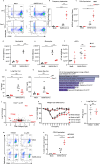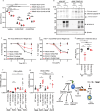This is a preprint.
TRIM7 ubiquitinates SARS-CoV-2 membrane protein to limit apoptosis and viral replication
- PMID: 38948778
- PMCID: PMC11212893
- DOI: 10.1101/2024.06.17.599107
TRIM7 ubiquitinates SARS-CoV-2 membrane protein to limit apoptosis and viral replication
Update in
-
TRIM7 ubiquitinates SARS-CoV-2 membrane protein to limit apoptosis and viral replication.Nat Commun. 2024 Nov 30;15(1):10438. doi: 10.1038/s41467-024-54762-5. Nat Commun. 2024. PMID: 39616206 Free PMC article.
Abstract
SARS-CoV-2 is a highly transmissible virus that causes COVID-19 disease. Mechanisms of viral pathogenesis include excessive inflammation and viral-induced cell death, resulting in tissue damage. We identified the host E3-ubiquitin ligase TRIM7 as an inhibitor of apoptosis and SARS-CoV-2 replication via ubiquitination of the viral membrane (M) protein. Trim7 -/- mice exhibited increased pathology and virus titers associated with epithelial apoptosis and dysregulated immune responses. Mechanistically, TRIM7 ubiquitinates M on K14, which protects cells from cell death. Longitudinal SARS-CoV-2 sequence analysis from infected patients revealed that mutations on M-K14 appeared in circulating variants during the pandemic. The relevance of these mutations was tested in a mouse model. A recombinant M-K14/K15R virus showed reduced viral replication, consistent with the role of K15 in virus assembly, and increased levels of apoptosis associated with the loss of ubiquitination on K14. TRIM7 antiviral activity requires caspase-6 inhibition, linking apoptosis with viral replication and pathology.
Keywords: Antiviral activity; Apoptosis; Caspase-6; E3-Ubiquitin ligases; Membrane protein; SARS-CoV-2; TRIM7; Ubiquitination.
Conflict of interest statement
Declaration of interest The authors declare no competing interests.
Figures






References
Publication types
Grants and funding
LinkOut - more resources
Full Text Sources
Molecular Biology Databases
Research Materials
Miscellaneous
